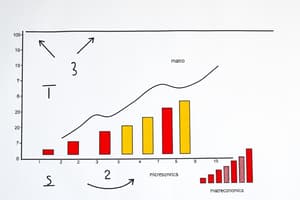Podcast
Questions and Answers
What is the primary focus of microeconomics?
What is the primary focus of microeconomics?
- Individual consumers and firms (correct)
- Global trade and economics
- Government policy and taxation
- National income and inflation
Which factor of production includes machinery and tools?
Which factor of production includes machinery and tools?
- Labor
- Entrepreneurship
- Capital (correct)
- Land
What characterizes a monopoly market structure?
What characterizes a monopoly market structure?
- Single seller controls the market (correct)
- Many buyers and sellers with identical products
- Many firms with differentiated products
- Few firms dominate the market
What does the Gross Domestic Product (GDP) measure?
What does the Gross Domestic Product (GDP) measure?
Which economic system advocates for public or collective ownership of resources?
Which economic system advocates for public or collective ownership of resources?
What is the relationship defined by the Law of Demand?
What is the relationship defined by the Law of Demand?
What does fiscal policy involve?
What does fiscal policy involve?
What is a common characteristic of oligopoly market structures?
What is a common characteristic of oligopoly market structures?
Flashcards are hidden until you start studying
Study Notes
Key Concepts in Economics
-
Definition of Economics
- Study of how societies allocate scarce resources.
- Focuses on production, distribution, and consumption of goods and services.
-
Branches of Economics
- Microeconomics
- Examines individual consumers and firms.
- Analyzes supply and demand, pricing, and consumer behavior.
- Macroeconomics
- Studies the economy as a whole.
- Focuses on national income, unemployment, inflation, and economic growth.
- Microeconomics
-
Basic Economic Problem
- Scarcity: Limited resources vs. unlimited wants.
- Forces choices about production and consumption.
-
Factors of Production
- Land: Natural resources used in production.
- Labor: Human effort used in the creation of goods.
- Capital: Machinery and tools used in production.
- Entrepreneurship: Initiative to combine resources for goods/services.
-
Market Structures
- Perfect Competition
- Many buyers and sellers, identical products.
- Monopolistic Competition
- Many firms, differentiated products.
- Oligopoly
- Few firms dominate the market.
- Monopoly
- Single seller controls the market.
- Perfect Competition
-
Economic Indicators
- Gross Domestic Product (GDP): Total value of goods/services produced.
- Unemployment Rate: Percentage of workforce that is jobless.
- Inflation Rate: Rise in general price levels.
-
Supply and Demand
- Law of Demand: As price decreases, quantity demanded increases.
- Law of Supply: As price increases, quantity supplied increases.
- Equilibrium: Point where supply equals demand.
-
Government and Economics
- Fiscal Policy: Government spending and taxation decisions.
- Monetary Policy: Control of money supply and interest rates by central banks.
-
Global Economics
- Trade: Exchange of goods/services between countries.
- Exchange Rates: Price of one currency in terms of another.
- Globalization: Increased interconnectedness of economies.
-
Economic Systems
- Capitalism: Private ownership of resources.
- Socialism: Public or collective ownership.
- Mixed Economy: Combines elements of capitalism and socialism.
-
Current Economic Issues
- Income inequality, trade wars, climate change impacts, technological advancement, and labor market shifts.
Definition of Economics
- Economics studies how societies allocate scarce resources to meet unlimited wants.
- It focuses on production, distribution, and consumption of goods and services.
Branches of Economics
- Microeconomics explores individual consumers and firms, analyzing supply and demand, pricing, and consumer behavior.
- Macroeconomics studies the economy as a whole, focusing on national income, unemployment, inflation, and economic growth.
Basic Economic Problem
- Scarcity: Limited resources exist to fulfill unlimited wants, requiring choices about production and consumption.
Factors of Production
- Land: Natural resources like water, minerals, and land itself, used in production.
- Labor: Human effort involved in creating goods and services.
- Capital: Machinery, tools, and equipment used in production.
- Entrepreneurship: The initiative to combine resources for goods/services, taking risks and managing businesses.
Market Structures
- Perfect Competition: Many buyers and sellers, identical products.
- Monopolistic Competition: Many firms, differentiated products, allowing some price control.
- Oligopoly: Few firms dominate the market, leading to strategic interactions.
- Monopoly: Single seller controls the market, potentially leading to higher prices and less choice.
Economic Indicators
- Gross Domestic Product (GDP): Total value of goods and services produced within a country's borders in a specific period.
- Unemployment Rate: Percentage of the workforce seeking employment but unable to find it.
- Inflation Rate: Rise in the general price levels over time, impacting purchasing power.
Supply and Demand
- Law of Demand: As the price of a good decreases, the quantity demanded increases.
- Law of Supply: As the price of a good increases, the quantity supplied increases.
- Equilibrium: Point where supply and demand forces balance, determining market price and quantity.
Government and Economics
- Fiscal Policy: Government's use of spending and taxation decisions to influence economic activity.
- Monetary Policy: Central bank's control of money supply and interest rates to manage inflation and stimulate growth.
Global Economics
- Trade: Exchange of goods and services between countries, driven by comparative advantage and specialization.
- Exchange Rates: Price of one currency expressed in terms of another, impacting trade flows and international competitiveness.
- Globalization: Increasing interconnectedness of economies through trade, investment, and technological advancements.
Economic Systems
- Capitalism: Private ownership of resources, with free markets and competition.
- Socialism: Public or collective ownership of resources, with government planning and regulation.
- Mixed Economy: Combines elements of both capitalism and socialism, with varying degrees of government intervention.
Current Economic Issues
- Income inequality, trade wars, climate change impacts, technological advancement, and labor market shifts are contemporary challenges.
Studying That Suits You
Use AI to generate personalized quizzes and flashcards to suit your learning preferences.




